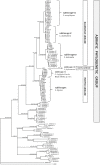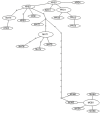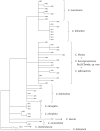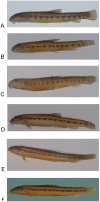Combining morphology and genetics in resolving taxonomy--a systematic revision of spined loaches (Genus Cobitis; Cypriniformes, Actinopterygii) in the Adriatic watershed
- PMID: 24918426
- PMCID: PMC4053515
- DOI: 10.1371/journal.pone.0099833
Combining morphology and genetics in resolving taxonomy--a systematic revision of spined loaches (Genus Cobitis; Cypriniformes, Actinopterygii) in the Adriatic watershed
Abstract
Taxonomic investigation of spined loaches from Dalmatia and Herzegovina was conducted on specimens from 14 localities. The results of the detailed morphological investigations were combined with genetic data (based on one mitochondrial and two nuclear genes) in order to resolve the taxonomic status of each Cobitis population. Among the investigated features of external morphology, the appearance of spots on the caudal fin base turned out to have the greatest diagnostic value. Furthermore, the number of branched fin rays enabled the discrimination of several species. No morphometric character alone could ensure determination of any Cobitis species. Nevertheless, groups of populations that are more similar in their body shapes correspond to mitochondrial phylogenetic lineages. Based on molecular genetic markers, Dalmatian and Herzegovinian spined loaches form independent lineages inside the Adriatic phylogenetic group. Mitochondrial DNA phylogenetic reconstruction revealed six monophyletic lineages, corresponding to six species distributed in the investigated area. The population distributed in Mostarsko blato karstic field in Bosnia and Herzegovina is described as a new species based on a unique combination of morphological characters: a single triangular Canestrini scale; usually 51/2 branched anal fin rays, 61/2 branched dorsal fin rays, 14 branched caudal fin rays; no spots in the surface pigmentation layer on the caudal fin base; scales on the body very small.
Conflict of interest statement
Figures












References
-
- Chen X, Jiang K, Guo P, Huang S, Rao D, et al.. (2014) Assessing species boundaries and the phylogenetic position of the rare Szechwan ratsnake, Euprepiophis perlaceus (Serpentes: Colubridae), using coalescent-based methods. Mol Phylogenet Evol 70: 130–136. - PubMed
-
- Knowles LL, Carstens BC (2007) Delimiting Species without Monophyletic Gene Trees. Syst Biol 56: 887–895. - PubMed
-
- Sites JW, Marshall JC (2004) Empirical criteria for delimiting species. Ann Rev Ecol Evol Syst 35: 199–227.
-
- Grummer JA, Bryson jr RW, Reeder TW (2014) Species Delimitation Using Bayes Factors: Simulations and Application to the Sceloporus scalaris Species Group (Squamata: Phrynosomatidae). Syst Biol 63: 119133. - PubMed
Publication types
MeSH terms
Substances
LinkOut - more resources
Full Text Sources
Other Literature Sources

